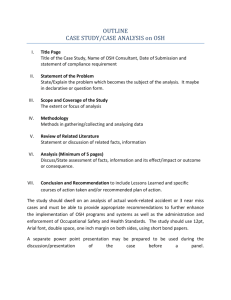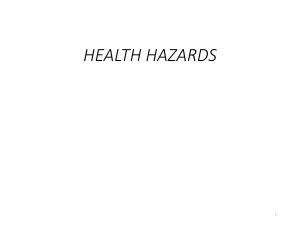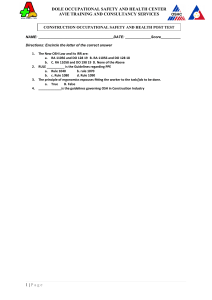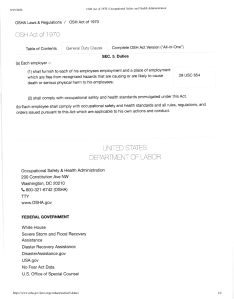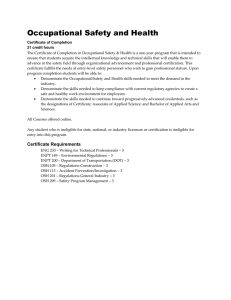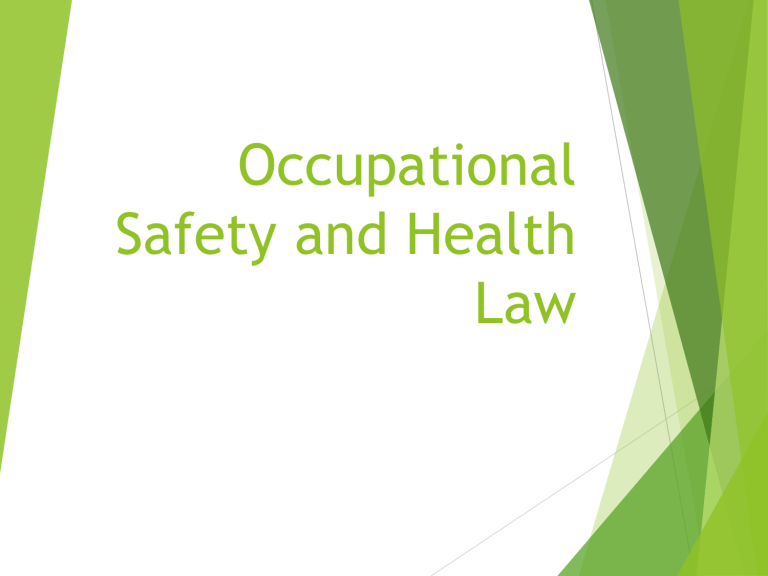
Occupational Safety and Health Law Occupational Safety and Health Law Republic Act No. 11058 – “an act strengthening compliance with occupational safety and health standards and providing penalties for violations thereof”, also known as OSH Law. Department Order No. 198 s. 2018 – Implementing Rules and Regulation of RA No. 11058. Occupational Safety and Health Law The law mandates the State to ensure a safe and healthful workplace to all working people by protecting them from hazards in their work environment. Ensures that all provisions of the Labor Code of the Philippines, domestic laws, internationally-recognize standards on OSH are fully enforced and complied by the employers. It shall also issue penalties for any violations. IRR of RA no. 11058 (Coverage) The act covers all establishments, projects and sites and all other places where work is being undertaken in all branches of economic activity. (e.g., establishments inside special economics zones; utilities engage in air, sea and land transportation; industries like mining, fishing, construction, agriculture and maritime; contractors and subcontractors engage in the projects of private and public sectors. The law does not apply to public sector such as government agencies or government-owned companies, government financial institutions, SUCs and LGUs IRR of RA no. 11058 (Definition of Terms) Certified first-aider – any person trained and duly certified to administer first aid by the Philippine Red Cross (PRC) or any organization authorized by the DOLE Secretary. Covered Workplaces – establishments, projects, sites and all other places where work is being undertaken wherein the number of employees, nature of operations and risk or hazard involved in the business as determined by the Secretary of Labor and Employment, require compliance with the provisions of DO 198-18. IRR of RA no. 11058 (Definition of Terms) Department of Labor and Employment (DOLE) Accredited Training Organizations – refer to those which have been granted accreditation by DOLE pursuant to Department Order No. 16, s. 2001. Employer – any person, natural or juridical, including the contractor, subcontractor, and principal employer who directly or indirectly benefit from the services of the employee. IRR of RA no. 11058 (Definition of Terms) Equipment – any machine with engine or electric motor as prime mover. General safety and health inspection – an examination of the work environment, including the location and operation of machinery other than those covered by technical safety audits, ventilation, and other possible sources of safety and health hazards. IRR of RA no. 11058 (Definition of Terms) High risk establishment – refers to a workplace wherein the presence of hazard or potential hazard within the company may affect the safety and/or health of workers IRR of RA no. 11058 (Definition of Terms) 1. 2. 3. 4. 5. 6. 7. The following are workplaces commonly associated with potentially high-risk activities: Chemical works and chemical production plants; Construction; Deep sea fishing; Explosives and pyrotechnics factories; Firefighting; Healthcare facilities; Installation of communication accessories, towers and cables; 8. LPG filling, refilling, storage and distribution; 9. Mining; 10.Petrochemical works and refineries; 11. Power generation, transmission and distribution in the energy sector; 12. Storage and distribution center for toxic or hazardous chemicals; 13. Storage of fertilizers in high volume; 14. Transportation; 15. Water supply, sewerage, waste management, remediation activities; 16. Works in which chlorine is used in bulk; and 17. Activities closely similar to those enumerated above and other activities as determined by DOLE in accordance with existing issuances on the classification of establishments. IRR of RA no. 11058 (Definition of Terms) Imminent danger – a situation caused by a condition or practice in any place of employment that could reasonably be expected to lead to death or serious physical harm. Low risk establishment – a workplace where there is low level of danger or exposure to safety and health hazards and not likely or with low probability to result in accident, harm or illness. IRR of RA no. 11058 (Definition of Terms) Medium risk establishment – a workplace where there is moderate exposure to safety and health hazards and with probability of an accident, injury or illness. Micro and Small Enterprises (MSEs) – establishments employing less than 10 employees and the establishments employing less than 100 employees, respectively, regardless of capitalization. IRR of RA no. 11058 (Definition of Terms) Occupational Health Personnel – a qualified first-aider, nurse, dentist or physician engaged by the employer to provide occupational health services in the establishment, project, site or workplace. Occupational Safety and Health (OSH) Consultant – a qualified Safety Officer 4 or its equivalent, duly certified by DOLE to perform and/or render consultative services on OSH in at least 2 fields of specialization as determined by DOLE. IRR of RA no. 11058 (Definition of Terms) Occupational Safety and Health (OSH) Practitioner – a qualified Safety Officer 3 or its equivalent, duly certified by DOLE to render occupational safety and health services in a defined and specific scope or core competency. Occupational Safety and Health (OSH) standards – a set of rules issued by DOLE which mandates the adoption and use of appropriate practices, means, methods, operations or processes, and working conditions to ensure safe and healthful employment. IRR of RA no. 11058 (Definition of Terms) Personal Protective Equipment (PPE) – a specialized clothing or equipment designed to protect workers against safety and health hazards that may cause serious workplace injuries and illnesses. Safety and Health Committee – a body created within the workplace tasked with the authority to plan, develop and implement OSH policies and programs, monitor and evaluate the OSH program, and inspect and investigate all aspects of the work pertaining to safety and health of workers. IRR of RA no. 11058 (Definition of Terms) Safety and Health program – a set of detailed rules to govern company policies, processes and practices in all economic activities to conform with OSH standards. Safety Officer – any employee or officer of the company trained by DOLE or DOLE-Accredited Training Organization and tasked by the employer to implement an OSH program. Safety Officer 1 (SO1) – an employee who has completed the mandatory 8-hour OSH orientation course as prescribed in the OSH standards and 2-hour trainer’s training. IRR of RA no. 11058 (Definition of Terms) Safety Officer 2 (SO2) – an employee who has completed the mandatory forty 40-hour OSH training course applicable to the industry as prescribed in the OSH standards. Safety Officer 3 (SO3) 40-hour OSH training course applicable to the industry additional 48 hours of advanced/ specialized OSH training course at least 2 years experience in OSH. IRR of RA no. 11058 (Definition of Terms) Safety Officer 4 (SO4) 40-hour OSH training course 80 hours of advanced/ specialized Occupational Safety training course aggregate of 320 hours of OSH related training or experience Safety Signage – any emergency, warning or danger signpost using the standard colors and sizes, including the standard symbols for safety instructions and warnings in the workplace IRR of RA no. 11058 (Definition of Terms) Worker – any member of the labor force, regardless of employment status Workers’ OSH Seminar – the mandatory 8-hour module conducted by the safety officer of the workplace as prescribed by the OSH standards IRR of RA no. 11058 (Duties of Employers) Equip a place of employment for workers free from hazardous conditions that are causing or are likely to cause death, illness, or physical harm Ensure that the chemical, physical and biological substances and agents, and ergonomic and psychosocial stresses under control are without risk to health Comply with OSHS including training, medical examination, and where necessary, provisions on protective and safety devices such as PPE and machine guards IRR of RA no. 11058 (Duties of Employers) Provide, where necessary, for measures identifying trainings and drills, evacuation plans, etc. to deal with emergencies, fires and accidents including first-aid arrangements Comply with all reportorial requirements of the OSH standards Register establishment to DOLE as provided under rule 1020 of the OSH standards IRR of RA no. 11058 (Duties of Workers) Participate in capacity building activities on safety and health and other OSH related topics and programs; Proper use of all safeguards and safety devices furnished for workers’ protection and that of others Comply with instructions to prevent accidents or imminent danger situations in the workplace Observe prescribed steps to be taken in cases of emergency Report to their immediate supervisor any work hazard that may be discovered in the workplace. IRR of RA no. 11058 (WORKERS’ RIGHT TO REFUSE UNSAFE WORK) The worker has the right of refusal to work without threat or reprisal from the employer if, as determined by DOLE, an imminent danger situation exists. As a preventive measure, the safety officer may, following his/her own determination and without fear of reprisal, implement a work stoppage or suspend operations in cases of imminent danger. The employer or safety officer cannot require the workers to return to work where there is a continuing imminent danger. IRR of RA no. 11058 WORKERS’ RIGHT TO REPORT ACCIDENTS Workers and their representatives shall have the right to report accidents, dangerous occurrences, and hazards to the employer, to DOLE and to other concerned competent government agencies. Reporting of accidents to DOLE may be made through any means of communication, including the DOLE hotline, whichever is most convenient to the worker. The same may be reported to the nearest DOLE Regional, Field, Provincial or Satellite Office having jurisdiction over the place of the incident. IRR of RA no. 11058 WORKERS’ RIGHT TO PERSONAL PROTECTIVE EQUIPMENT (PPE) Every employer, contractor or subcontractor, if any, shall provide his/her workers, FREE OF CHARGE, PPE for any part of the body that may be exposed to hazards of causing injury or impairment in the function of any part of the body through absorption, inhalation or physical contact. IRR of RA no. 11058 Safety Signage and Devices All establishments, projects, sites and all other places where work is being undertaken shall have safety signage and devices to warn the workers and the public of the hazards in the workplace. Safety signage and devices shall be posted in prominent positions at strategic locations in a language understandable to all. SAFETY OFFICER Minimum classification and number of safety officer for all covered workplaces shall be as follows: Number of Workers 1 to 9 10 to 50 51 to 99 100 to 199 Low Risk One (1) SO1 Medium Risk High Risk One (1) SO1 One (1) SO2 One (1) SO2 One (1) SO2 200 to 250 Two (2) SO2 or one (1) SO3 251 to 500 501 to 750 Two (2) SO2 and one (1) SO3 751 to 1000 Two (2) SO3 One (1) SO2 and one (1) SO3 Two (2) SO3 One (1) SO3 One (1) SO2 and one (1) SO3 Two (2) SO3 One (1) SO2 and Two (2) SO3 Every additional of 250 or a fraction thereof - - Additional one (1) SO3 or SO4 Every additional of 500 or a fraction thereof Additional one (1) SO3 Additional one (1) SO3 or SO4 - OCCUPATIONAL HEALTH PERSONNEL AND FACILITIES OCCUPATIONAL HEALTH PERSONNEL AND FACILITIES OCCUPATIONAL HEALTH PERSONNEL AND FACILITIES OCCUPATIONAL HEALTH PERSONNEL AND FACILITIES The employer may not establish a hospital or dental clinic in the workplace where there is a hospital or dental clinic which is located not more than five (5) kilometers away from the workplace, accessible in not more than twenty-five (25) minutes travel time, and the employer has facilities readily available for transporting workers to the hospital or dental clinic in cases of emergency. For this purpose, the employer shall enter into a written contract with the hospital for the use of such hospital for the treatment of workers in cases of emergency. WORKERS’ WELFARE FACILITIES All establishments, projects, sites and all other places where work is being undertaken shall have the following free welfare facilities in order to ensure humane working conditions: Adequate supply of safe drinking water; Adequate sanitary and washing facilities; Suitable living accommodation for workers, as may be applicable such as in construction, shipping, fishing and night workers; Separate sanitary, washing and sleeping facilities for all gender, as may be applicable; Lactation station except those establishments as provided for under DOLE Department Order No. 143-15; Ramps, railings and the like; and Other workers’ welfare facilities as may be prescribed by the OSH standards and other issuances. PROHIBITED ACTS AND ITS CORRESPONDING PENALTIES End
